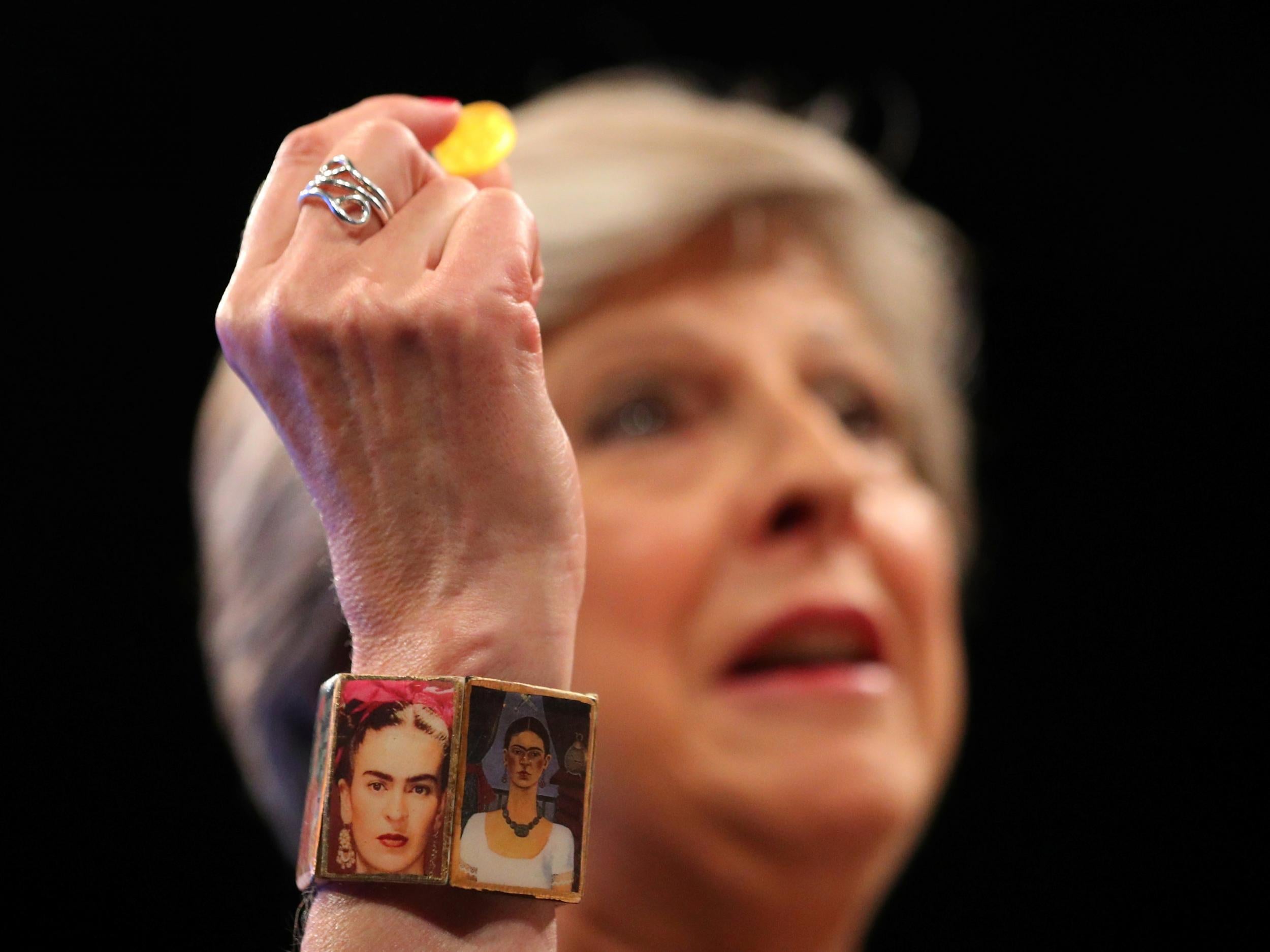How Frida Kahlo became a trinket for a Conservative leader
The Mexican artist and fervent Stalinist would be surprised to discover Theresa May’s choice of bracelet

Your support helps us to tell the story
From reproductive rights to climate change to Big Tech, The Independent is on the ground when the story is developing. Whether it's investigating the financials of Elon Musk's pro-Trump PAC or producing our latest documentary, 'The A Word', which shines a light on the American women fighting for reproductive rights, we know how important it is to parse out the facts from the messaging.
At such a critical moment in US history, we need reporters on the ground. Your donation allows us to keep sending journalists to speak to both sides of the story.
The Independent is trusted by Americans across the entire political spectrum. And unlike many other quality news outlets, we choose not to lock Americans out of our reporting and analysis with paywalls. We believe quality journalism should be available to everyone, paid for by those who can afford it.
Your support makes all the difference.Theresa May’s party leader speech at the Conservative conference last Wednesday was noteworthy for all the wrong reasons. As Kenzie Bryant noted in Vanity Fair, it became a speech about “a cough, a merry prankster, a bracelet”.
The fact that May was wearing a bracelet made up of miniature portraits of Frida Kahlo has become one of the major talking points of the speech. Many Kahlo fans will be delighted that this important Mexican artist has gained more exposure from the storm generated by May’s fashion statement. Nonetheless, it raises some interesting issues about the transformation and co-opting of radical leftist artists who achieve a certain degree of success.
The media attention is not, in this instance, a frivolous focus on fashion at the expense of taking political women seriously.
Rather, it is a collective amused gasp of wonder at a particularly right-wing Conservative leader choosing to adorn herself with a prominent bracelet featuring images of the most famous Communist female artist. And this at a time when ideological battles over socialism vs capitalism have been reignited in British politics with the rise of Jeremy Corbyn.
Media sources have pointed out the irony of May’s apparent enthusiasm for Kahlo and have noted the artist’s affair with Trotsky, her Marxist politics and her affiliation to the Mexican Communist party.
What they have omitted is that history presents a vision of Kahlo even more at odds with present day British Conservative politics – at the time of Kahlo’s death she was a fervent supporter of Stalin. In fact, she repudiated Trotsky, denying she ever supported his ideas, as Sarah Lowe observed in her book The Diary of Frida Kahlo: An Intimate Self-Portrait. Kahlo’s devotion to Stalin increased throughout her life and took on a religious fervour. On the death of Stalin in 1953 she writes in her diary (partially in capitals and without punctuation): “THE WORLD MEXICO THE WHOLE UNIVERSE has lost its balance with the loss of STALIN.”
Kahlo’s commodification
How, then, can we understand May or her stylist’s fashion choice. The answer lies in the way in which Kahlo has undergone a form of cultural transformation and commodification, a process in which a cultural figure becomes an icon and acquires a new market-derived identity. Kahlo’s work now sells for millions and rich and famous buyers including Madonna have acquired her work.
In previous work I have noted that Kahlo has been co-opted by a range of groups and has become what her fans and admirers desire her to be: a symbol for Mexicans, Mexican Americans, Latinos in the US, feminists and LGBTQ people all over the world, who take from her what fits their identity needs. Even so – she is not usually co-opted by representatives of conservative agendas, which is what has made the Frida bracelet story so newsworthy.
But then, since her death in July 1954, Kahlo has been transformed to make her less threatening to Western capitalist belief systems. The best-known account of her life was though her portrayal in the 2009 Hollywood film Frida, directed by Julie Taymor and starring Salma Hayek. The film takes great liberties with its source text, Hayden Herrera’s biography of the artist, Frida: A Biography of Frida Kahlo. This screen Frida is shown to be virulently anti-Stalin and passionately pro-Trotsky throughout her life, while specifics of her ideology and dogma are left out in favour of sweeping notions of workers’ rights.
The film transforms Kahlo into a transnational cultural icon that can be accessed by all – and her anti-Americanism, bisexuality, and her radical Stalinist politics are played down. In their place, Salma Hayek’s Frida embodies talent and physical attractiveness. Time and again, the filmic Frida overcomes suffering and the numerous infidelities of her famous husband, the muralist Diego Rivera.
It is no wonder that May – faced with the threats of betrayals of her cabinet and deeply unpopular with the electorate – channelled this version of Frida Kahlo and her narrative of triumph over adversity. Kahlo’s long battle with pain – so often referenced in her work – may present the Prime Minister with the ideal symbol for her own political travails. It is this Kahlo, the commodified powerful icon that May is comfortable embracing – not the Stalinist and Communist party activist who would have been horrified at being reduced to a fashion accessory on the Conservative leader’s wrist.
Deborah Shaw is a reader in film studies, at the University of Portsmouth. This article first appeared on The Conversation (theconversation.com)
Join our commenting forum
Join thought-provoking conversations, follow other Independent readers and see their replies
Comments